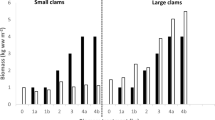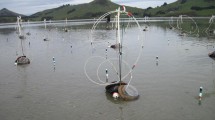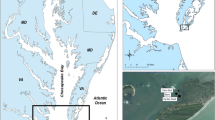Abstract
Bioturbation studies have generally analyzed small and abundant organisms while the contribution to the benthic metabolism by rare, large macrofauna has received little attention. We hypothesize that large, sporadic bivalves may represent a hot spot for benthic processes due to a combination of direct and indirect effects as their metabolic and bioturbation activities. Intact riverine sediments with and without individuals of the bivalve Sinanodonta woodiana were collected in a reach with transparent water, where the occurrence of the mollusk was clearly visible. The bivalve metabolism and its effects on sedimentary fluxes of dissolved gas and nutrients were measured via laboratory incubations of intact cores under controlled conditions. S. woodiana contributed significantly to O2 and TCO2 benthic fluxes through its respiration and to \({\text{NH}}_{4}^{ + }\), SRP and SiO2 regeneration via its excretion. The bivalve significantly stimulated also microbial denitrification and determined a large efflux of CH4, likely due a combination of bioturbation and biodeposition activities or to anaerobic metabolism within the mollusk gut. This study demonstrates that a few, large individuals of this bivalve produce significant effects on aerobic and anaerobic benthic metabolism and nutrient mobilization. Random sediment sampling in turbid waters seldom catches these important effects due to low densities of large fauna.



Similar content being viewed by others
References
Aller RC (1982) The effects of macrobenthos on chemical properties of marine sediment and overlying water. In: McCall PL, Tevest MJT (eds) Animal-sediment relations: the biogenic alteration of sediment, 2nd edn. Plenum Press, New York, pp 53–102
Amyot JP, Downing J (1998) Locomotion in Elliptio complanata (Mollusca: Unionidae): a reproductive function? Freshwater Biol 39:351–358
Anderson LG, Hall POJ, Iverfeldt A et al (1986) Benthic respiration measured by total carbonate production. Limnol Oceanogr 31:319–329
Baker SM, Hornbach DJ (2001) Seasonal metabolism and biochemical composition of two unionid mussels, Actinonaias ligamentina and Amblema plicata. J Mollus Stud 67:407–416
Balfour DL, Smock LA (1995) Distribution, age structure, and movements of the freshwater mussel Elliptio complanata (Mollusca: Unionidae) in a headwater stream. J Freshwater Ecol 10:255–268
Bartoli M, Nizzoli D, Welsh DT, Viaroli P (2000) Short-term influence of recolonisation by the polycheate worm Nereis succinea on oxygen and nitrogen fluxes and denitrification: a microcosm simulation. Hydrobiologia 431:165–174
Bartoli M, Nizzoli D, Viaroli P, Turolla E, Castaldelli G, Fano EA, Rossi R (2001) Impact of Tapes philippinarum farming on nutrient dynamics and benthic respiration in the Sacca di Goro. Hydrobiologia 455:203–212
Bartoli M, Naldi M, Nizzoli D, Roubaix V, Viaroli P (2003) Influence of clam farming on macroalgal growth: a microcosm experiment. Chem Ecol 19:147–160
Bartoli M, Longhi D, Nizzoli D, Como S, Magni P, Viaroli P (2009) Short term effects of hypoxia and bioturbation on solute fluxes, denitrification and buffering capacity in a shallow dystrophic pond. J Exp Mar Biol Ecol 381:105–113
Bower CE, Holm-Hansen T (1980) A salicylate-hypochlorite method for determining ammonia in seawater. Can J Fish Aquat Sci 37:794–798
Burla H (1971) Gerichtete Ortsveränderung bei Muscheln der Gattung Anodonta im Zürichsee. Vierteljahrsschrift Der Naturforschenden Gesellschaft in Zürich 116:181–194
Caraco NF, Cole JJ, Findlay SEG, Lampman GG, Pace ML, Strayer DL (2000) Dissolved oxygen declines in the Hudson River associated with the invasion of the zebra mussel (Dreissena polymorpha). Environ Sci Technol 34:1204–1210
Childress JJ, Fisher CR, Brooks JM, Kennicutt MC II, Bidigare R, Anderson AE (1986) A methanotrophic marine molluscan (Bivalvia, Mytilidae) symbiosis: mussels fueled by gas. Science 233:1306–1308
Conroy JD, Edwards WJ, Pontius RA, Kane DD, Zhang H, Shea JF, Culver A (2005) Soluble nitrogen and phosphorus excretion of exotic freshwater mussels (Dreissena spp.): potential impacts for nutrient remineralization in western Lake Erie. Freshwater Biol 50:1146–1162
Dalsgaard T, Nielsen LP, Brotas V et al (2000) Protocol handbook for NICE-nitrogen cycling in estuaries: a project under the EU research programme. In: Marine Science and Technology (MAST III), National Environmental Research Institute, Silkeborg
Gallepp GW (1979) Chironomid influence on phosphorus release in sediment-water microcosms. Ecology 60:547–556
Glud RN, Blackburn N (2002) The effects of chamber size on benthic oxygen uptake measurements: a simulation study. Ophelia 56:23–31
Golterman HL, Clymo RS, Ohnstand MAM (1978) Methods for physical and chemical analysis of fresh waters. In: I.B.P. Handbook Nr. 8. Blackwell, Oxford
Hakenkamp CC, Palmer MA (1999) Introduced bivalves in freshwater ecosystems: the impact of Corbicula on organic matter dynamics in a sandy stream. Oecologia 119:445–451
Hansen K, King GM, Kristensen E (1996) Impact of the soft-shell clam Mya arenaria on sulfate reduction in an intertidal sediment. Aquat Microb Ecol 10:181–194
Higgins SN, Zanden MJV (2010) What a difference a species makes: a meta-analysis of dreissenid mussel impacts on freshwater ecosystems. Ecol Monogr 80:179–196
Hölker F, Vanni MJ, Kuiper JJ et al (2015) Tube-dwelling invertebrates: tiny ecosystem engineers have large effects in lake ecosystems. Ecol Monogr 85:333–351
Kiibus M, Kautsky N (1996) Respiration, nutrient excretion and filtration rate of tropical freshwater mussels and their contribution to production and energy flow in Lake Kariba, Zimbabwe. Hydrobiologia 331:25–32
Kristensen E, Penha-Lopes G, Delefosse M, Valdemarsen T, Quintana CO, Banta GT (2012) What is bioturbation? The need for a precise definition for fauna in aquatic sciences. Mar Ecol Prog Ser 446:285–302
Lorenzen CJ (1967) Determination of chlorophyll and phaeopigments: spectrophotometric equations. Limnol Oceanogr 12:343–346
Magni P, Montani S (2005) Laboratory experiments on bivalve excretion rates of nutrients. Water Encycl 4:6–11
Manganelli G, Bodon M, Favilli L, Castagnolo L, Giusti F (1998) Checklist of the species of the Italian fauna, terrestrial and freshwater mollusks. Bollettino Malacologico Italiano 33:151–156
McMahon RF (1991) Mollusca: Bivalvia. In: Thorp JH, Covich AP (eds) Ecology and classification of North American freshwater invertebrates. Academic Press, San Diego, pp 315–399
Murphy AE, Anderson IC, Luckenbach MW (2015) Enhanced nutrient regeneration at commercial hard clam (Mercenaria mercenaria) beds and the role of macroalgae. Mar Ecol Prog Ser 530:135–151
Na T, Gribsholt B, Galaktionov OS, Lee T, Meysman FJR (2008) Influence of advective bio-irrigation on carbon and nitrogen cycling in sandy sediments. J Mar Res 66:691–722
Nalepa TF, Gardner WS, Malczyk JM (1991) Phosphorus cycling by mussels (Unionidae: Bivalvia) in Lake St. Clair. Hydrobiologia 219:239–250
Nichols SJ, Silverman H, Dietz TH, Lynn JW, Garling DL (2005) Pathways of food uptake in native (Unionidae) and introduced (Corbiculidae and Dreissenidae) freshwater bivalves. J Great Lakes Res 31:87–96
Nielsen LP (1992) Denitrification in sediment determined from nitrogen isotope paring. FEMS Microbiol Ecol 86:357–362
Nizzoli D, Welsh DT, Fano EA, Viaroli P (2006) Impact of clam and mussel farming on benthic metabolism and nitrogen cycling, with emphasis on nitrate reduction pathways. Mar Ecol Prog Ser 315:151–165
Nizzoli D, Bartoli M, Cooper M, Welsh DT, Underwood GJC, Viaroli P (2007) Implications for oxygen, nutrient fluxes and denitrification rates during the early stage of sediment colonisation by the polychaete Nereis spp. in four estuaries. Estuar Coast Shelf Sci 75:125–134
Nizzoli D, Welsh DT, Longhi D, Viaroli P (2014) Influence of Potamogeton pectinatus and microphytobenthos on benthic metabolism, nutrient fluxes and denitrification in a freshwater littoral sediment in an agricultural landscape: N assimilation versus N removal. Hydrobiologia 737:183–200
Norkko J, Reed DC, Timmermann K et al (2012) Welcome can of worms? Hypoxia mitigation by an invasive species. Glob Change Biol 18:422–434
Palmer MA, Covich AP, Finlay BJ et al (1997) Biodiversity and ecosystem processes in freshwater sediments. Ambio 26:571–577
Pelegrí SP, Blackburn TH (1995) Effects of Tubifex tubifex (Oligochaeta: Tubificidae) on N-mineralization in freshwater sediments, measured with 15isotopes. Aquat Microb Ecol 9:289–294
Pelegrí SP, Nielsen LP, Blackburn TH (1994) Denitrification in estuarine sediment stimulated by the irrigation activity of the amphipod Corophium volutator. Mar Ecol Prog Ser 105:285–290
Prins TC, Smaal AC, Dame RF (1998) A review of the feedbacks between bivalve grazing and ecosystem processes. Aquat Ecol 31:349–359
Pusch M, Siefert J, Walz N (2001) Filtration and respiration rates of two unionid species and their impact on the water quality of a lowland river. In: Bauer G, Wächtler K (eds) Ecology and evolution of the freshwater mussels Unionidae. Springer, Berlin, pp 317–326
Raikow DF, Hamilton SK (2001) Bivalve diets in a midwestern U.S. stream: a stable isotope enrichment study. Limnol Oceanogr 46:514–522
Reid RGB, McMahon RF, Foighil DO, Finnigan R (1992) Anterior inhalant currents and pedal feeding in bivalves. The Veliger 35:93–104
Rota E, Bartoli M, Laini A (2014) First time in Italy. Is the elusive aquatic megadrile Sparganophilus Benham, 1892 (Annelida, Clitellata) accelerating its dispersal in Europe? J Limnol 73:482–489
Ruginis T, Bartoli M, Petkuviene J, Zilius M, Lubiene I, Laini A, Razinkovas-Baziukas A (2014) Benthic respiration and stoichiometry of regenerated nutrients in lake sediments with Dreissena polymorpha. Aquat Sci 76:405–417
Schwalb AN, Pusch MT (2007) Horizontal and vertical movements of unionid mussels in a lowland river. J N Am Benthol Soc 26:261–272
Stadmark J, Conley DJ (2011) Mussel farming as a nutrient reduction measure in the Baltic Sea: consideration of nutrient biogeochemical cycles. Mar Pollut Bull 62:1385–1388
Stief P (2013) Stimulation of microbial nitrogen cycling in aquatic ecosystems by benthic macrofauna: mechanisms and environmental implications. Biogeosciences 10:7829–7846
Strayer DL (2014) Understanding how nutrient cycles and freshwater mussels (Unionoida) affect one another. Hydrobiologia 735:277–292
Strayer DL, Hunter DC, Smith LC, Borg C (1994) Distribution, abundance, and role of freshwater clams (Bivalvia: Unionidae) in the freshwater tidal Hudson River. Freshwater Biol 31:239–248
Svensson JM (1997) Influence of Chironomus plumosus larvae on ammonium flux and denitrification (measured by the acetylene blockage- and the isotope pairing-technique) in eutrophic lake sediment. Hydrobiologia 346:157–168
Thamdrup B, Dalsgaard T (2002) Production of N2 through anaerobic ammonium oxidation coupled to nitrate reduction in marine sediments. Appl Environ Microbiol 68:1312–1318
Traganza ED, Swinnerton JW, Cheek CH (1979) Methane supersaturation and ATP-zooplankton blooms in near-surface waters of the Western Mediterranean and the subtropical North Atlantic Ocean. Deep Sea Res Part 1 Oceanogr Res Pap 26:1237–1245
Valderrama JC (1977) Methods used by the hydrographica department of the national board of fisheries. Goteborg, Sweden
Vaughn CC, Hakenkamp C (2001) The functional role of burrowing bivalves in freshwater ecosystems. Freshwater Biol 46:1431–1446
Vaughn CC, Gido KB, Spooner DE (2004) Ecosystem processes performed by unionid mussels in stream mesocosms: species roles and effects of abundance. Hydrobiologia 527:35–47
Vaughn CC, Nichols SJ, Spooner DE (2008) Community and foodweb ecology of freshwater mussels. J N Am Benthol Soc 27:409–423
Welsh DT, Castaldelli G (2004) Bacterial nitrification activity directly associated with isolated benthic marine animals. Mar Biol 144:1029–1037
Yamamuro M, Koike I (1993) Nitrogen metabolism of the filter-feeding bivalve Corbicula japonica and its significance in primary production of a brackish lake in Japan. Limnol Oceanogr 38:997–1007
Yeager MM, Cherry DS, Neves RJ (1994) Feeding and burrowing behaviors of juvenile rainbow mussels Villosa iris (Bivalvia:Unionidae). J N Am Benthol Soc 13:217–222
Zhang L, Shen Q, Hu H, Shao S, Fan C (2011) Impacts of Corbicula fluminea on oxygen uptake and nutrient fluxes across the sediment-water interface. Water Air Soil Poll 220:399–411
Acknowledgments
Paula Carpintero Moraes was supported by CNPq-Brasil.
Author information
Authors and Affiliations
Corresponding author
Additional information
Handling Editor: Piet Spaak.
Rights and permissions
About this article
Cite this article
Benelli, S., Bartoli, M., Racchetti, E. et al. Rare but large bivalves alter benthic respiration and nutrient recycling in riverine sediments. Aquat Ecol 51, 1–16 (2017). https://doi.org/10.1007/s10452-016-9590-3
Received:
Accepted:
Published:
Issue Date:
DOI: https://doi.org/10.1007/s10452-016-9590-3




